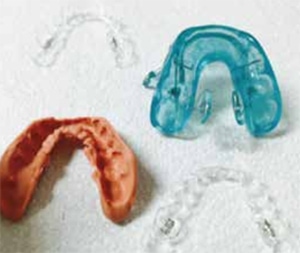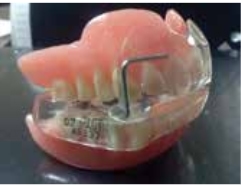
Two Systems, Great Results
The OASYS™ is one of the most versatile appliances on the market. Besides packing the punch of three different distinctive actions in one simple device, it has versatility in use in many special situations.
We all know that the OASYS™ is the only sleep device cleared by the ENT division of the FDA to treat nasal resistance with it’s patented nasal dilators but did you know that it’s special design makes it the preferred appliance to use in many other situations you will commonly encounter?
OASYS™ and Invisalign
Patients with airway problems commonly present with craniofacial and dental discrepancies that require orthodontic treatment in addition to their airway treatment or they simply wish to have orthodontic care for their aesthetics or crowding. The OASYS™ is the perfect appliance to use to combine Invisalign orthodontic treatment and airway therapy with oral appliances.
We all see a number of cases in which the patient presents with a retrognathic mandible and in the process of mandibular repositioning the mandible became stable in a more protrusive posture. Many of these cases were class II div I or post orthodontic treatment in which they were treated with extractions or headgear. These cases required orthodontics to procline the central incisors and sometimes to correct deep bites and crowding.
It is possible to treat the patient with Invisalign using the OASYS™ system due to enhanced design features. Whether the patient is already being treated for sleep apnea, wishes to have orthodontic treatment and needs to be able to continue their OSA therapy or the patient is in appliance therapy for sleep apnea and we see the need to add orthodontic care to the treatment plan, these clinical choices can be easily coordinated.
The process begins with the patient work-up using traditional orthodontic records and treatment planning. If the treatment can be performed using Invisalign and OASYS™ appliance, the treatment is started by ordering the Invisalign aligners. The upper Invisalign aligners becomes the upper cushion component of the OASYS™ appliance – the system has the functional unit attached only to the mandibular arch and an “upper cushion” very similar to clear aligners. Used together, the upper arch aligners require no modifications to work as the upper component.
For the lower arch the base of the OASYS™ will need to fit over the aligners in place and provide room for the changes desired over the course of treatment. If the patient is not currently using a sleep device, it is best that the impressions for the MAD be taken when the Invisalign is delivered and the buttons have been placed. The impressions are taken with the first aligners in place to approximate the spacing needed for future aligners and movement. A layer of PVS inner liner will provide retention of the OASYS™ during treatment. If the patient already has a device, the base of the appliance is ground out to allow space for the aligner and future movement though the full course of treatment.
At delivery, I insert the first aligners and place PVS impression material into the inner base and position the OASYS™ over the lower arch to mold the PVS around the aligner. The base may need a mechanical lock to hold it in as PVS does not adhere to the acrylic of the base. Cutting into the inner base or adding acrylic to form undercuts to the lower edges of the base in a couple of areas is usually enough mechanical lock.
As the Invisalign treatment progresses, I will see the patient every six weeks or 3 aligners, pulling out the old PVS material and adding new material into the lower base. This takes very little time and is usually done by my dental assistant.
These simple steps will allow you to partner with your patient to give them two good results. The small amount of extra work is a good investment for customizing your service! Join the rapidly growing number of doctors using the OASYS™ for combination of airway and orthodontic treatment.
OASYS™ and Upper Denture
After considering the OASYS™ device over aligners, it’s easy to see how it can also be used directly over an upper denture without any modifications. The denture is the upper element; by taking your typical lower impression, with your usual bite registration, you have it! Full denture cases still require implant support on the lower arch.

